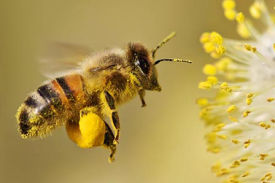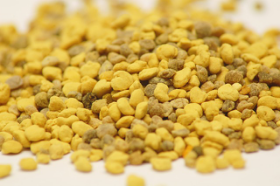Hot New Products Organic Bee pollen Wholesale to Indonesia
Hot New Products Organic Bee pollen Wholesale to Indonesia Detail:
[Products Name] Bee pollen
[Specification]
Tea bee pollen
Mixed bee pollen
Pure Rape bee pollen
Bee pollen Extrac
[Gerneral feature]
1. Low antibiotics;
2.Organic certified by ECOCERT, according to EOS & NOP organic standard;
3.100% pure natural bee pollen, no additives;
[Introduction]
Bee pollen is the pollen agglomerate which was collected from plant and processed by bees, and was called almighty nutrition food, concentrated natural drug storeroom, to be taken orally cosmetic, concentrated amino acid etc, bee pollen is the gem of human natural food.
Pollen can be harvested by the beekeeper from the bees as they enter their hive. It is then cleaned and either dried or frozen before being included in natural remedies and food supplements.
[Functions]
Bee pollen can enhance body colligate immunity function, prevent from caducity, hairdressing, prevent from cardiovascular virus, prevention and cure prostate virus, adjust intestines and stomach function, adjust nerve system, accelerate sleep, cure other viruses assistant such as anemia, diabetes, improve memory and the balk of menopause.
Pollen can be used as Honey Bee Pollen .Honey Bee Pollen is a mixture of bee pollen (milled), royal jelly. It is a liquid product and the recommended dose is 2 teaspoonful per day preferably with breakfast.
Pollen contains no additives or preservatives. It is suitable for all ages, but particularly those who have a hectic lifestyle, or older people who are in their advanced years and would benefit from a pleasant tasting, easy to take liquid product with added important vitamins which they might not be getting in their normal diet.
Most people take this on a regular basis as a breakfast supplement. It can provide a boost to a general feeling of well being for those feeling below par. Not only does it impart the effect of royal jelly but the pollen is extremely nutritious containing many amino acids and proteins.
[Application] It was widely used in health tonic, health pharmacy, hairdressing and cosmetic area.
Product detail pictures:

Related Product Guide:
Our personnel are always in the spirit of "continuous improvement and excellence", and with the superior quality products, favorable price and good after-sales services, we try to win every customer's trust for Hot New Products Organic Bee pollen Wholesale to Indonesia , The product will supply to all over the world, such as: Israel, Jordan, Uganda, If you need to have any of our merchandise, or have other items to be produced, make sure you send us your inquiries, samples or in depth drawings. Meanwhile, aiming to develop into an international enterprise group, we look forward to receiving offers for joint ventures and other cooperative projects.
Additional information for viewers of Riverbank Media’s film, Invasion Vermont (check out the Invasion Vermont Playlist here on our YouTube channel or visit our website)
www.riverbankmedia.org
Learn more about candida yeast die-off and what you can do to avoid aggravations.
And what this poor lady did is she dropped the treatment she was doing entirely and went on a very powerful cleansing regime. She started to take right off the bat, 60 drops of grapefruit seed extract per day, 6 capsules of oregano oil per day, one liter of a very strong anti-fungal tea, different kinds of tea she was drinking, 5 tablespoons of coconut oil, and a very strict diet. All carbs were gone. It was like a meat diet with some eggs in it. Literally within a couple of days, she felt unwell, but she kept the treatment going and pushing and pushing. She ended up in the emergency room. She thought she was dying of a heart attack. She had chest pains, she had facial pains, and she couldn’t sleep. I think it lasted almost two weeks this headache. It was a severe headache on one side of the face. She thought her head was going to explode. She was vomiting. She couldn’t sleep. She had severe aggravations.
Well, these things can come about when you do a 360, when you do an about turn, and do a very abrupt stop of everything you’re doing and a very abrupt start of everything new and in particular in high dosages. You can cause a serious aggravation. This is not what I want people to do. And in my book, I’ve written about this on many occasions that you’re better off to slowly wind down, especially if you’re eating a poor diet, just slowly take your diet down over a two or three week period and gently introduce new foods. And at that time, it’s probably not a good idea to put antifungal treatment in right from day one. You’re better off cleaning yourself up a little bit in terms of diet and lifestyle and then putting an antifungal approach in there. And when you do, you start on a low dose if you have severe Candida, then you gradually build up. It may take two or three weeks before you can start taking even a reasonable amount of antifungal.
I’ve had this same thing with people taking my Canxida Remove and Canxida Restore products. Some people will start, they take 12 straightaway, so they’ll get the bottle, and they’ll take three tablets, 2 hours later another three, then another three. Some people seem to think that if you take a huge amount of something, you’re going to hurry up and quickly get the cleanse over and done with. You’re going to kill all the Candida in your body. This is a stupid way of thinking. If you want to feel really sick and get bad aggravations, go ahead, take lots and lots of things. Make lots and lots of changes abruptly. It’s not a good idea.
For example, if you’re going to join a gym or going to get fit, you’re not going to go to the gym on day one and do three hours of weights and then go out and do 50 miles on a bike, and then a week later, you won’t be able to walk for a month. No. You don’t do that. You go very slowly into exercise. Very slowly and get a reasonable level of fitness, then build that fitness up gradually until you become increasingly fit. And who knows, in six months, you may be able to do a quarter or half marathon. You can’t do a half marathon in Candida the first week that you start a Candida cleanse. It doesn’t work like that. And if you do that, you’ll get severe aggravations.
So take it easy. You’ve got plenty of time. You’ve been to 50 doctors or practitioners already; you’ve gotten nowhere. Why would you think that you could push things through in a hurry and get somewhere? If you’re going to do it properly, take your time. Do it properly. Because I want you to also learn and become educated in the correct lifestyle habits as well as diet habits. Remember, a lot of products you can take can be very powerful if taken in dosages way too high. I mean 60 drops of grapefruit seed extract on day one is not a good approach. You can get very sick doing that.
Have a think about that suggestion. I thought it might be worthwhile doing a video on this topic. Go slow. Go low. Take it easy and gradually build. Work under the threshold of discomfort. You don’t want to push yourself to the point where you’re vomiting and you have to go to the hospital. That’s not really a good idea.
Candida Diet: https://www.youtube.com/watch?v=R9327DEOWcc
Candida Cleanse: https://www.youtube.com/watch?v=VwUBdS-dPZM
Candida Foods To Avoid: https://www.youtube.com/watch?v=8_9ntEF2_YU
Candida Foods To Eat: https://www.youtube.com/watch?v=Ccm4X8wKRPI
The company comply with the contract strict, a very reputable manufacturers, worthy a long-term cooperation.







